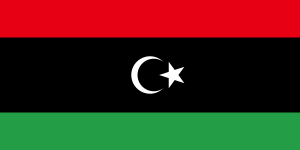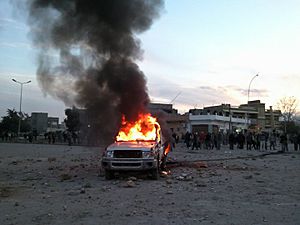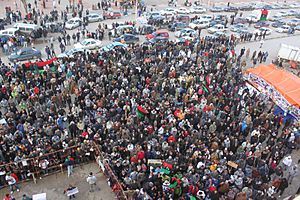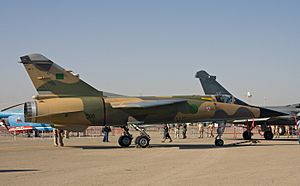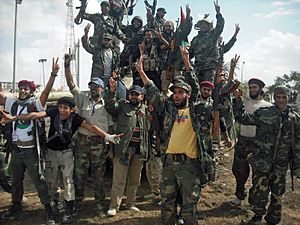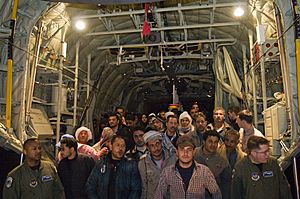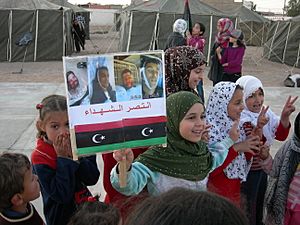First Libyan Civil War facts for kids
Quick facts for kids First Libyan Civil War |
|||||||
|---|---|---|---|---|---|---|---|
| Part of the Arab Spring and the Libyan Crisis | |||||||
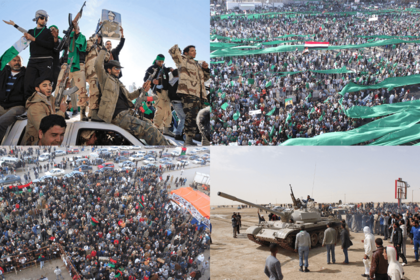 From left to right: Armed pro-government supporters; Pro-government protesters gathered in Green Square, now known as Martyrs' Square; anti-Government protesters in Benghazi; Libyan rebels on a tank. |
|||||||
|
|||||||
| Belligerents | |||||||
|
Enforcing UNSC Resolution 1973: NATO members
Other countries
Minor border clashes: |
|
||||||
| Commanders and leaders | |||||||
|
|
|||||||
| Strength | |||||||
|
200,000 volunteers by war's end International Forces: Numerous air and maritime forces (see here) |
20,000–50,000 soldiers & militiamen | ||||||
| Casualties and losses | |||||||
| 5,904–6,626 killed (other estimates: see here) |
3,309–4,227 soldiers killed (other estimates: see here) 7,000 captured* |
||||||
| Total casualties (including civilians): 9,400–25,000 killed 4,000 missing 50,000 wounded (other estimates: see here) |
|||||||
| *Large number of loyalist or immigrant civilians, not military personnel, among those captured by rebels, only an estimated minimum of 1,692+ confirmed as soldiers | |||||||
The First Libyan Civil War was a big fight in 2011 in the country of Libya, located in North Africa. It was fought between forces loyal to Colonel Muammar Gaddafi and rebel groups. These rebels wanted to remove Gaddafi's government from power. The war started with protests, also known as the 17 February Revolution.
The protests began in Benghazi on 15 February 2011. They quickly grew into a rebellion that spread across Libya. The groups against Gaddafi formed a temporary government called the National Transitional Council.
The United Nations Security Council took action. On 26 February, they froze Gaddafi's money and limited his travel. They also asked the International Criminal Court to investigate. In early March, Gaddafi's forces fought back, taking over some cities.
Another UN resolution allowed countries to create a no-fly zone over Libya. This meant no planes could fly in certain areas. It also allowed "all necessary measures" to protect civilians. This led to a bombing campaign by NATO against Libyan military targets. Gaddafi's government announced a ceasefire, but the fighting continued. Rebels refused ceasefire offers because they wanted Gaddafi to leave power.
In August, rebel forces launched a big attack on the coast of Libya. They were helped by NATO's bombing campaign. Rebels took back land and eventually captured the capital city of Tripoli. Gaddafi managed to escape for a while. On 16 September 2011, the United Nations recognized the National Transitional Council as Libya's official government. Muammar Gaddafi was captured and killed on 20 October 2011 in Sirte. The National Transitional Council declared Libya "liberated" on 23 October 2011, officially ending the war.
After the war, some fighting continued from Gaddafi's supporters. There were also disagreements between local groups and tribes. Some armed groups from the war refused to give up their weapons. This led to more problems and eventually a second civil war in 2014.
Contents
Why the War Started
Gaddafi's Rule in Libya
Muammar Gaddafi took power in Libya in 1969. He removed King Idris I in a peaceful takeover. He changed Libya's old constitution. From 1969 to 1975, life in Libya improved quickly. People lived longer, more people could read, and living standards went up.
Gaddafi wrote a book called The Green Book. It explained his ideas for how Libya should be run. He officially stepped down from power in 1977. He said he was just a "symbolic figurehead" after that. However, many believed he still controlled everything.
Libya was supposed to be a direct democracy. This meant people would rule through local committees. But Gaddafi often controlled these groups. He kept his family and loyal tribe members in important government and military jobs. He also made sure no one person became too powerful, even his own sons. This helped him stay in charge for a long time.
Gaddafi was worried about a military takeover. So, he kept Libya's army quite weak. The army had about 50,000 soldiers. The strongest units were four special brigades. These were made up of soldiers from Gaddafi's own tribe or other loyal tribes. One of these brigades was led by his son, Khamis.
Life in Libya Before the War
By the end of Gaddafi's 42-year rule, Libya had a good income per person. This was thanks to its large oil production. However, about a third of people still lived in poverty.
Libya became a mostly non-religious society. Child marriage was stopped. Women had equal pay for equal work and equal rights in divorce. More women went to college. Homelessness was very low. Most people could read, and people lived longer lives.
Libya's economy relied heavily on oil. Oil made up most of the country's earnings. Libya is a member of OPEC, a group of oil-producing countries. It was one of the world's biggest oil producers. The country also had a large fund of money, including over 100 tons of gold.
Despite these good points, there were problems. Libya was seen as a corrupt country. Many businesses were controlled by Gaddafi and his family. They lived very rich lifestyles. Gaddafi himself had a huge personal fortune.
Gaddafi did try to fight corruption. He suggested giving oil money directly to the people. He wanted to break down government offices to stop corruption. But a vote in 2009 delayed this plan. Some officials worried it would cause economic problems.
Human Rights and Freedoms
Libya had strict rules about what people could say. News and media were heavily controlled. In 2009 and 2011, Libya was ranked as one of the most censored countries.
The government said that Libya was a direct democracy. They claimed citizens could freely share their opinions. They also said no one suffered from extreme poverty or hunger.
However, there were also secret police and informants. These groups watched people closely in government, factories, and schools. Speaking out against the government was illegal. If you tried to start a political party, you could be executed.
Gaddafi's The Green Book was the main text for political education. Teachers who criticized it could face serious punishment. In 1988, Gaddafi said that "true revolutionaries" do not use repression. He also released a document about human rights. It said citizens had the right to express their opinions. But some restrictions remained.
The Anti-Gaddafi Movement
Early Protests
In January 2011, people in cities like Bayda and Benghazi protested. They were upset about delays in housing projects and government corruption. Protesters broke into empty government-built homes. They also clashed with police. The government tried to calm things by investing money in housing.
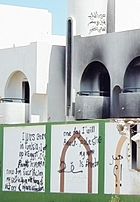
A writer named Jamal al-Hajji asked people online to protest for more freedoms. He was arrested in February. This happened after similar protests in Tunisia and Egypt had removed their leaders. Social media played a big role in organizing the opposition.
The Uprising Begins
Serious protests began on 2 February 2011. They were called the Libyan Revolution of Dignity. On 15 February, hundreds of people protested in Benghazi. They were angry about the arrest of a human rights lawyer. Protesters threw firebombs and stones. Police used tear gas and rubber bullets. Many people were injured.
On 16 February, protesters in Bayda, Zawiya, and Zintan set police buildings on fire. A "Day of Rage" was planned for 17 February. Protests happened in many cities. Libyan security forces fired live bullets at the crowds. Protesters burned government buildings. In Tripoli, TV stations and government offices were attacked.
By 18 February, police and army left Benghazi. Some soldiers even joined the protesters. They took over the local radio station. In Bayda, some police and riot units also joined the protesters. There were reports of helicopters firing into crowds.
Music and the Revolt
Music, especially rap and hip hop, helped encourage people to protest. In many Arab Spring countries, governments controlled music. But in Libya, music became a way for protesters to communicate. It gave them moral support and a spirit of rebellion.
An artist called Ibn Thabit used his music to criticize Gaddafi. He posted songs online, starting in 2008. His songs gave a voice to Libyans who wanted change. Another band, "Guys Underground," used metaphors to criticize the government. They released a song that made fun of an autocratic family head, which was a hidden reference to Gaddafi.
Organizing the Opposition
Many opposition members wanted to bring back the 1952 constitution. They wanted a multi-party democracy. Soldiers who joined the rebellion formed fighting groups. They worked to take control of cities from Gaddafi's forces. In Tobruk, volunteers turned a government building into a center for helping protesters. They guarded the port and banks. Teachers and engineers helped collect weapons. Volunteers also organized supply lines, even delivering pizzas to fighters in Misrata.
The National Transitional Council (NTC) was formed on 27 February. Its goal was to unite the rebel efforts. It also represented the opposition to the world. The NTC, based in Benghazi, asked for a no-fly zone and airstrikes against Gaddafi's forces. They called themselves the Libyan Republic. They planned for free elections and a new constitution.
An independent newspaper called Libya started in Benghazi. Rebel-controlled radio stations also began broadcasting. Some rebels showed their dislike for tribalism. They wore vests saying "No to tribalism, no to factionalism."
Who Were the Rebels?

The rebels were mostly ordinary people. They included teachers, students, lawyers, and oil workers. Some police officers and professional soldiers also joined them. Many religious groups were part of the rebel movement. Rebel groups mainly came from Misrata, Zintan, and Derna.
Gaddafi's government often claimed that the rebels included al-Qaeda fighters. Rebels denied this. NATO's commander said there were small signs of al-Qaeda activity. But there wasn't enough information to confirm a large presence of terrorist groups.
Responses to the War
Government Officials Leaving
Many senior Libyan officials left Gaddafi's government. They did this because of the violence against protesters. The Justice Minister, Mustafa Abdul Jalil, and Interior Minister, Abdul Fatah Younis, joined the opposition. The Oil Minister and Foreign Minister also fled Libya.
Many Libyan diplomats around the world also spoke out against Gaddafi. Ambassadors to the Arab League, European Union, and United Nations resigned or said they no longer supported the government.
Military Members Joining the Rebels
Several high-ranking military officers joined the opposition. Two Libyan Air Force colonels flew their fighter jets to Malta and asked for safety. They had been ordered to bomb civilians in Benghazi. The commander of the Benghazi Naval Base also joined the rebels.
The Royal Family's View
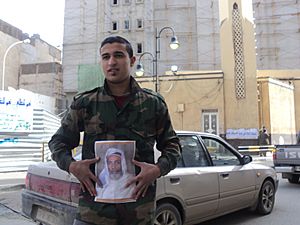
Muhammad as-Senussi, a relative of the former King of Libya, offered his sympathy to those killed. He asked the world to stop supporting Gaddafi. He also spoke to Al Jazeera, asking for help to remove Gaddafi. He wanted a no-fly zone but no foreign ground troops. He said Libyan people and tribes were united.
How the War Unfolded
First Weeks of Fighting
By 23 February, Gaddafi was losing support. Many allies had left him. He had lost control of major cities like Benghazi, Misrata, and Tobruk. He also lost important harbors. But in early March, Gaddafi's forces fought back. They pushed the rebels away and reached Benghazi and Misrata again. The fighting became more intense.
Foreign Countries Step In
On 2 March 2011, a Canadian navy ship was sent to Libya's coast. Seventeen days later, a group of countries started military action. They were following a UN resolution to protect civilians. US forces and a British submarine fired missiles. Air forces from Canada, France, the US, and the UK flew missions over Libya. The British navy also set up a blockade.
More countries joined the effort, making it 17 states. Most of these new countries helped enforce the no-fly zone and naval blockade. They also provided military support. The US first led the effort. NATO took control of the arms embargo on 23 March. This was called Operation Unified Protector. NATO later agreed to control the no-fly zone.
In June 2011, Muammar Gaddafi and his son said they were willing to hold elections. Gaddafi said he would step down if he lost. But NATO and the rebels refused this offer. NATO then continued bombing Tripoli.
Rebels Attack Tripoli
On 21 August, rebel leaders said Gaddafi's son was arrested. They also said they had surrounded Gaddafi's compound. This suggested the war was almost over. By 22 August, rebel fighters entered Tripoli. They took over Green Square, renaming it Martyrs' Square.
On 23 August, rebels broke into Gaddafi's compound in Tripoli. But no members of his family were found inside. Gaddafi later said his withdrawal was a "tactical" move. Fighting continued in Tripoli, with many people injured or killed.
After Tripoli Fell
Rebels continued to fight Gaddafi's forces in northwestern Libya and towards Sirte. They captured the city of Ghadames on 29 August. Members of Gaddafi's family fled to Algeria. In September, rebels surrounded Bani Walid, where Gaddafi's son was thought to be hiding. On 22 September, the NTC captured Sabha in the south.
By mid-October 2011, NTC forces had taken most of Sirte. But fierce fighting continued in the city center. The NTC captured all of Sirte on 20 October 2011. Muammar Gaddafi was captured and killed in Sirte on the same day.
On 1 September, Russia recognized the Libyan NTC as the only legal government. China also recognized the NTC on 12 September.
What Happened After the War
Even after Gaddafi's death, his son, Saif al-Islam, remained hidden until his capture in November. Some loyalist forces also went into Niger. Small clashes between the NTC and former loyalists continued in Libya.
On 3 January 2012, fighting broke out in a building used by Gaddafi's intelligence. The NTC chairman warned that Libya could fall into another civil war. He said this if people used force to solve their problems.
On the same day, Libya's government named a retired general as head of the armed forces. On 23 January, local fighters captured Bani Walid. They felt the NTC was not working with them.
The NTC acted as a temporary government. In May 2012, they gave immunity to former rebel fighters for their actions during the war. They also ordered that all people accused of fighting for Gaddafi be tried or released. They passed a law against criticizing the revolution or praising Gaddafi.
A report in 2013 said Libya was in a bad political and economic crisis. Oil production had almost stopped. The government had lost control of large areas to armed groups. Violence increased across the country. By May 2014, conflicts led to a second civil war.
Impact of the War
People Affected
It is hard to know the exact number of people killed or injured in the war. Estimates have varied a lot. On 24 February, Libya's ambassador to Malta said about 300 people had died. This included civilians, police, and soldiers. Other estimates were much higher.
In June 2011, Amnesty International said earlier estimates were too high. They estimated about 100-110 people died in Benghazi and 59-64 in Bayda during the first few days.
Targeting of Groups
In August 2011, the UNHCR said that black Africans in Libya were being targeted by rebel forces. This happened as cities fell. Many black Africans worked in Libya before the war. Some were mistaken for fighters who supported Gaddafi.
Amnesty International reported that many people held in detention centers were from Sub-Saharan Africa. The town of Tawergha, which supported Gaddafi, was emptied of its mostly black residents. This seemed to be a punishment by anti-Gaddafi fighters. One commander said, "Tawergha no longer exists."
People Fleeing Libya
Many people fled Libya because of the violence. As many as 4,000 refugees crossed into Tunisia every day at the start of the uprising. These included Libyans and foreign workers. By 1 March, about 200,000 refugees had fled to Tunisia or Egypt.
A refugee camp at Ras Ajdir was set up for 10,000 people. But it quickly became overcrowded with 20,000 to 30,000 refugees. Many tens of thousands were still stuck on the Libyan side of the border. Aid groups worked to provide food and medical help.
Economic and Tribal Effects
Oil prices around the world went up during the war. This was because Libya has a lot of oil. An oil company in Libya said it would use oil money to support the anti-Gaddafi forces. Religious leaders in Libya also urged Muslims to rebel against Gaddafi.
Some tribes, like the Magarha and Zuwayya, supported the protesters. The Tuareg people consistently supported Gaddafi during the war. Gaddafi had given many Tuareg people safety and supported their culture. Some Tuareg fighters said they would fight for Gaddafi until the end. Tuareg areas like Ghat remain strongholds for Gaddafi's supporters even today.
Images for kids
-
Loyalist Palmaria howitzers destroyed by the French air force near Benghazi in Opération Harmattan on 19 March 2011
-
President Barack Obama speaking on the military intervention in Libya at the National Defense University.
See also
 In Spanish: Guerra de Libia de 2011 para niños
In Spanish: Guerra de Libia de 2011 para niños
- Arab Spring
- Human rights in Libya
- Military history of Libya
- Revolutions in Libya



